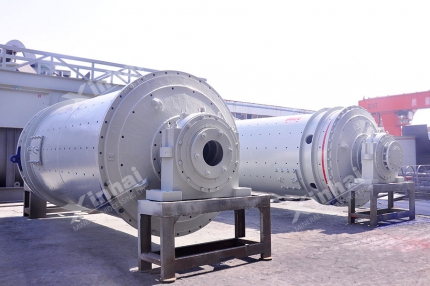Ball milling process generally refers to the process manufacturing ball mills, and sometimes refers to a process with ball mills as the main equipment. In nature, copper ore often occurs in association with some rare metals, with molybdenum as the most common associated mineral. Copper ore and molybdenum ore is one of the principal raw materials making copper and molybdenum. When processing copper-molybdenum ore, stage grinding and stage separating methods are normally adopted. Here I will give a brief introduction to ball milling process for cooper-molybdenum dressing.
According to related statistics, the lowest industrial grade of copper ore by underground mining is from 0.4 to 0.5 percent, and open mining 0.4 percent; the lowest industrial grade of molybdenum by underground mining is from 0.06 to 0.08 percent, and open mining 0.06 percent. Therefore, the concentration ratio of copper-molybdenum processing is rather great. It is advisable to get the mixed concentrates by bulk flotation first and obtain the copper concentrates and molybdenum concentrates by separation flotation then. So two-stage grinding operation is often used in the design of copper-molybdenum ball milling process. With features like uniform product size, less over-grinding, fast discharging speed and bigger capacity, grid ball mills are applied in the first-stage grinding work in general. The ores with suitable grain size after crushing will be ground to achieve the primary separation of useful minerals, copper and molybdenum, and gauge minerals. Then hydrocyclones are used to sorting the grinding products meeting the target size and transmit them to finish the mixed flotation process, while the underflows is sent back to the mills for re-grinding.
After mixed flotation process, copper concentrates and molybdenum concentrates are recycled and foam concentrates are transmitted to the second-stage grinding while flotation tailings are directly disserted. Since the re-grinding mills often process ores with finer product sizes and less quantity, overflow ball mills accounts for a big proportion in re-grinding process. The mixed ores are crushed further and copper and molybdenum ore are separated. The separated ore will finally become concentrates after processes of concentration, filtering and drying. In the design of ball milling process, the grinding stages are commonly decided by the dissemination size of useful minerals in raw ore. If coarse particles evenly embed, first-stage grinding work is suggestive; if fine particles evenly embed second-stage grinding work first and then further separation is advisable; if the coarse and fine particles embed unevenly, stage grinding process is preferred.
As a professional ball mills manufacturer in China, Xinhai can provide ball mills with various types and complete specifications, thus earning great credits from its customers.


 marketing@ytxinhai.com
marketing@ytxinhai.com  0086 13810327080
0086 13810327080 






































































































 CHAT
CHAT MESSAGE
MESSAGE.jpg)


